Kinetics of Oxygen Reduction Reaction of Polymer-Coated MWCNT-Supported Pt-Based Electrocatalysts for High-Temperature PEM Fuel Cell
Abstract
:1. Introduction
2. Experimental Procedure
2.1. Materials
2.2. Functionalization of MWCNT
2.3. Composite Preparation
2.4. Synthesis of Electrocatalysts
2.5. Characterization
3. Results and Discussion
3.1. Surface Morphology
3.2. Surface Topography and Particle Size Distribution
3.3. Determination of Crystalline Phases
3.4. Chemical Structure Analysis
3.5. Electrochemical Analysis
| Sample Items | Pt Loading | ECSA (m2/g) | JK (mA/cm2) | Electrons Transfer (n) | % of HO2− Species | Ref. |
|---|---|---|---|---|---|---|
| MWCNT-Pt | 0.01 mg/cm2 | 17.66 | −0.96 (at 0.2 V) | 3.83 | 8.62 | This work |
| MWCNT-PBI-Pt | 0.01 mg/cm2 | 24.31 | −1.45 (at 0.2 V) | 3.99 | 0.72 | This work |
| MWCNT-Nafion-Pt | 0.01 mg/cm2 | 22.48 | −1.26 (at 0.2 V) | 3.84 | 7.86 | This work |
| MWCNT-PTFE-Pt | 0.01 mg/cm2 | 20.85 | −1.16 (at 0.2 V) | 4.01 | 0.02 | This work |
| MWCNT-PVP-Pt | 50% (wt.) | 60.91 | 9.33 (at 0.45 V) | 2.9 | - | [52] |
| MWCNT-PVP-PWA-Pt | 50% (wt.) | 69.9 | 35.7 (at 0.45 V) | 3.9 | - | [52] |
| MWCNT-PTFE-Pt | 0.01 mg/cm2 | - | 0.28 (at −0.38 V) | 3.89 | 11.34 | [53] |
| MWCNT-Pt | 0.01 mg/cm2 | - | 0.22 (at −0.38 V) | 3.77 | - | [53] |
| DWCNT-Pt | 0.031 mg/cm2 | - | 0.88 (at 0.8 V) | 4.18 | - | [54] |
| MWCNT-Pt-1 | 0.031 mg/cm2 | - | 1.72 (at 0.8 V) | 3.83 | - | [54] |
| MWCNT-Pt-2 | 0.031 mg/cm2 | - | 1.30 (at 0.8 V) | 3.69 | - | [54] |
4. Conclusions
- I.
- MWCNT-supported Pt-based electrocatalysts coated with polymers were synthesized successfully by the polyol method which was endorsed by several microstructural and performance characterization techniques such as XRD, Raman spectroscopy, and electrochemical analysis.
- II.
- TEM image depicts that the Pt nanoparticles were deposited consistently on the polymer-coated MWCNT surfaces with Pt nanoparticle sizes ranging from 4.3 nm to 6.2 nm.
- III.
- Electron transfer numbers (n) were found to be 3.83 for MWCNT-Pt, 3.99 for MWCNT-PBI-Pt, 3.84 for MWCNT-Nafion-Pt, and 4.01 for MWCNT-PTFE-Pt, which suggests that the ORR reaction mechanism of electrocatalysts is controlled by four electron transfer reaction pathways.
- IV.
- All modified MWCNT-supported Pt electrocatalysts exhibit high electrochemically active surface areas and limiting current density compared to pristine MWCNT-based Pt electrocatalysts, but the modification by PBI produced the best results.
- V.
- The kinetics of ORR reactions reveals that the modified MWCNT-based electrocatalysts provide low HO2−% species at zero potential while MWCNT-Pt electrocatalysts provide high HO2−% species. In addition, the yield of high HO2−% species can decrease the ORR.
- VI.
- The newly developed catalysts, in particular the MWCNT-PBI-Pt, produced higher ORR compared to the traditional ones, indicating greater efficiency in the PEM fuel cell through a reduction in electrode cost and Pt mass loading.
Author Contributions
Funding
Data Availability Statement
Acknowledgments
Conflicts of Interest
References
- Tian, L.; Qiu, G.; Shen, Y.; Wang, X.; Wang, J.; Wang, P.; Song, M.; Li, J.; Li, T.; Zhuang, W.; et al. Carbon Quantum Dots Modulated NiMoP Hollow Nanopetals as Efficient Electrocatalysts for Hydrogen Evolution. Ind. Eng. Chem. Res. 2019, 58, 14098–14105. [Google Scholar] [CrossRef]
- Gong, X.; Liu, S.; Ouyang, C.; Strasser, P.; Yang, R. Nitrogen- and Phosphorus-Doped Biocarbon with Enhanced Electrocatalytic Activity for Oxygen Reduction. ACS Catal. 2015, 5, 920–927. [Google Scholar] [CrossRef]
- Zhang, J. PEM Fuel Cells and Platinum-Based Electrocatalysts: Encyclopedia of Sustainability Science and Technology; Springer: New York, NY, USA, 2013. [Google Scholar] [CrossRef]
- Wong, W.; Daud, W.; Mohamad, A.; Loh, K. Effect of temperature on the oxygen reduction reaction kinetic at nitrogen-doped carbon nanotubes for fuel cell cathode. Int. J. Hydrogen Energy 2015, 40, 11444–11450. [Google Scholar] [CrossRef]
- Zhang, J.; Tang, S.; Liao, L.; Yu, W.; Li, J.; Seland, F.; Haarberg, G.M. Improved catalytic activity of mixed platinum catalysts supported on various carbon nanomaterials. J. Power Sources 2014, 267, 706–713. [Google Scholar] [CrossRef]
- Gupta, C.; Maheshwari, P.H.; Sasikala, S.; Mathur, R.B. Processing of pristine carbon nanotube supported platinum as catalyst for PEM fuel cell. Mater. Renew. Sustain. Energy 2014, 3, 36. [Google Scholar] [CrossRef]
- Galeano, C.; Meier, J.C.; Soorholtz, M.; Bongard, H.; Baldizzone, C.; Mayrhofer, K.J.J.; Schüth, F. Nitrogen-Doped Hollow Carbon Spheres as a Support for Platinum-Based Electrocatalysts. ACS Catal. 2014, 4, 3856–3868. [Google Scholar] [CrossRef]
- Toh, S.Y.; Loh, K.S.; Kamarudin, S.K.; Daud, W.R.W. The impact of electrochemical reduction potentials on the electrocatalytic activity of graphene oxide toward the oxygen reduction reaction in an alkaline medium. Electrochimica Acta 2016, 199, 194–203. [Google Scholar] [CrossRef]
- Haque, M.A.; Sulong, A.; Loh, K.; Majlan, E.H.; Husaini, T.; Rosli, R.E. Acid doped polybenzimidazoles based membrane electrode assembly for high temperature proton exchange membrane fuel cell: A review. Int. J. Hydrogen Energy 2017, 42, 9156–9179. [Google Scholar] [CrossRef]
- Soo, L.T.; Loh, K.S.; Mohamad, A.B.; Daud, W.R.W.; Wong, W.Y. Effect of nitrogen precursors on the electrochemical performance of nitrogen-doped reduced graphene oxide towards oxygen reduction reaction. J. Alloys Compd. 2016, 677, 112–120. [Google Scholar] [CrossRef]
- Li, W.; Liang, C.; Zhou, W.; Qiu, J.; Zhou, Z.; Sun, G.; Xin, Q. Preparation and Characterization of Multiwalled Carbon Nanotube-Supported Platinum for Cathode Catalysts of Direct Methanol Fuel Cells. J. Phys. Chem. B 2003, 107, 6292–6299. [Google Scholar] [CrossRef]
- Serp, P.; Corrias, M.; Kalck, P. Carbon nanotubes and nanofibers in catalysis. Appl. Catal. A Gen. 2003, 253, 337–358. [Google Scholar] [CrossRef]
- Wang, C.; Waje, M.; Wang, X.; Tang, J.M.; Haddon, R.C.; Yan, Y. Proton Exchange Membrane Fuel Cells with Carbon Nanotube Based Electrodes. Nano Lett. 2003, 4, 345–348. [Google Scholar] [CrossRef]
- Said, Z.; Rahman, S.; Sharma, P.; Hachicha, A.A.; Issa, S. Performance characterization of a solar-powered shell and tube heat exchanger utilizing MWCNTs/water-based nanofluids: An experimental, numerical, and artificial intelligence approach. Appl. Therm. Eng. 2022, 212, 118633. [Google Scholar] [CrossRef]
- AlOtaibi, M.; Alsuhybani, M.; Khayyat, M.; AlOtaibi, B. Performance of Nanocomposites of a Phase Change Material Formed by the Dispersion of MWCNT/TiO2 for Thermal Energy Storage Applications. Materials 2022, 15, 3063. [Google Scholar] [CrossRef]
- Balasubramanian, K.; Burghard, M. Chemically Functionalized Carbon Nanotubes. Small 2005, 1, 180–192. [Google Scholar] [CrossRef]
- Li, X.; Hsing, I.-M. The effect of the Pt deposition method and the support on Pt dispersion on carbon nanotubes. Electrochimica Acta 2006, 51, 5250–5258. [Google Scholar] [CrossRef]
- Wang, S.; Jiang, S.P.; White, T.J.; Guo, J.; Wang, X. Electrocatalytic Activity and Interconnectivity of Pt Nanoparticles on Multiwalled Carbon Nanotubes for Fuel Cells. J. Phys. Chem. C 2009, 113, 18935–18945. [Google Scholar] [CrossRef]
- Matsumoto, K.; Fujigaya, T.; Sasaki, K.; Nakashima, N. Bottom-up design of carbon nanotube-based electrocatalysts and their application in high temperature operating polymer electrolyte fuel cells. J. Mater. Chem. 2010, 21, 1187–1190. [Google Scholar] [CrossRef]
- Zeis, R. Materials and characterization techniques for high-temperature polymer electrolyte membrane fuel cells. Beilstein J. Nanotechnol. 2015, 6, 68–83. [Google Scholar] [CrossRef] [Green Version]
- Tintula, K.K.; Sahu, A.K.; Shahid, A.; Pitchumani, S.; Sridhar, P.; Shukla, A.K. Mesoporous Carbon and Poly(3,4-ethylenedioxythiophene) Composite as Catalyst Support for Polymer Electrolyte Fuel Cells. J. Electrochem. Soc. 2010, 157, B1679. [Google Scholar] [CrossRef]
- Yang, Z.; Moriguchi, I.; Nakashima, N. Durable Pt Electrocatalyst Supported on a 3D Nanoporous Carbon Shows High Performance in a High-Temperature Polymer Electrolyte Fuel Cell. ACS Appl. Mater. Interfaces 2015, 7, 9800–9806. [Google Scholar] [CrossRef]
- Haque, M.A. Physiochemical Characteristics of Solid Electrolyte Membranes for High-Temperature PEM Fuel Cell. Int. J. Electrochem. Sci. 2019, 14, 371–386. [Google Scholar] [CrossRef]
- Rosli, R.; Sulong, A.; Daud, W.W.; Zulkifley, M.; Rosli, M.; Majlan, E.; Haque, M.; Radzuan, N.M. The design and development of an HT-PEMFC test cell and test station. Int. J. Hydrogen Energy 2019, 44, 30763–30771. [Google Scholar] [CrossRef]
- Wu, J.; Yuan, X.Z.; Martin, J.J.; Wang, H.; Zhang, J.; Shen, J.; Wu, S.; Merida, W. A review of PEM fuel cell durability: Degradation mechanisms and mitigation strategies. J. Power Sources 2008, 184, 104–119. [Google Scholar] [CrossRef]
- Shao, Y.; Yin, G.; Wang, J.; Gao, Y.; Shi, P. Multi-walled carbon nanotubes based Pt electrodes prepared with in situ ion exchange method for oxygen reduction. J. Power Sources 2006, 161, 47–53. [Google Scholar] [CrossRef]
- Ye, S.; Hall, M.; Cao, H.; He, P. Degradation Resistant Cathodes in Polymer Electrolyte Membrane Fuel Cells. ECS Trans. 2006, 3, 657–666. [Google Scholar] [CrossRef]
- Berber, M.R.; Fujigaya, T.; Sasaki, K.; Nakashima, N. Remarkably Durable High Temperature Polymer Electrolyte Fuel Cell Based on Poly(vinylphosphonic acid)-doped Polybenzimidazole. Sci. Rep. 2013, 3, srep01764. [Google Scholar] [CrossRef]
- Su, H.; Pasupathi, S.; Bladergroen, B.; Linkov, V.; Pollet, B.G. Performance Investigation of Membrane Electrode Assemblies for High Temperature Proton Exchange Membrane Fuel Cell. J. Power Energy Eng. 2013, 1, 95–100. [Google Scholar] [CrossRef]
- Hafez, I.H.; Berber, M.R.; Fujigaya, T.; Nakashima, N. Enhancement of Platinum Mass Activity on the Surface of Polymer-wrapped Carbon Nanotube-Based Fuel Cell Electrocatalysts. Sci. Rep. 2014, 4, srep06295. [Google Scholar] [CrossRef] [Green Version]
- Scheibe, B.; Borowiak-Palen, E.; Kalenczuk, R.J. Oxidation and reduction of multiwalled carbon nanotubes—Preparation and characterization. Mater. Charact. 2010, 61, 185–191. [Google Scholar] [CrossRef]
- Spitalsky, Z.; Tasi, D.; Papgelis, K.; Galioti, C. Carbon nanotube-polymer composites: Chemistry, processing mechanical and electrical properties. Prog. Polym. Sci. 2010, 35, 357–401. [Google Scholar] [CrossRef]
- Pu, L.; Zou, L.; Zhou, Y.; Zou, Z.; Yang, H. High performance MWCNT–Pt nanocomposite-based cathode for passive direct methanol fuel cells. RSC Adv. 2017, 7, 12329–12335. [Google Scholar] [CrossRef]
- Zhang, J.; Xie, Z.; Zhang, J.; Tang, Y.; Song, C.; Navessin, T.; Shi, Z.; Song, D.; Wang, H.; Wilkinson, D.P.; et al. High temperature PEM fuel cells. J. Power Sources 2006, 160, 872–891. [Google Scholar] [CrossRef]
- Silva-Carrillo, C.; Reynoso-Soto, E.A.; Félix-Navarro, R.M.; Lin-Ho, S.W.; Díaz-Rivera, A.; Paraguay-Delgado, F.; Chávez-Carvayar, J.; Alonso-Núñez, G. Organic Solvent’s Effect in the Deposition of Platinum Particles on MWCNTs for Oxygen Reduction Reaction. J. Nanomater. 2016, 2016, 5783920. [Google Scholar] [CrossRef]
- Kang, W.; Li, F.; Zhao, Y.; Qiao, C.; Ju, J.; Cheng, B. Fabrication of porous Fe2O3/PTFE nanofiber membranes and their application as a catalyst for dye degradation. RSC Adv. 2016, 6, 32646–32652. [Google Scholar] [CrossRef]
- Shulga, Y.M.; Vasilets, V.N.; Kiryukhin, D.P.; Voylov, D.N.; Sokolov, A.P. Polymer composites prepared by low-temperature post-irradiation polymerization of C2F4 in the presence of graphene-like material: Synthesis and characterization. RSC Adv. 2015, 5, 9865–9874. [Google Scholar] [CrossRef]
- Pandey, M.; Joshi, G.M.; Deshmukh, K.; Khutia, M.; Ghosh, N.N. Optimized AC conductivity correlated to structure, morphology and thermal properties of PVDF/PVA/Nafion composites. Ionics 2014, 20, 1427–1433. [Google Scholar] [CrossRef]
- Meng, F.-L.; Jia, Y.; Liu, J.-Y.; Li, M.-Q.; Sun, Y.-F.; Huang, X.-J. Nanocomposites of sub-10 nm SnO2 nanoparticles and MWCNTs for detection of aldrin and DDT. Anal. Methods 2010, 2, 1710–1714. [Google Scholar] [CrossRef]
- Zdrojek, M.; Gebicki, W.; Jastrzebski, C.; Melin, T.; Huczko, A. Studies of Multiwall Carbon Nanotubes Using Raman Spectroscopy and Atomic Force Microscopy. Solid State Phenom. 2004, 99–100, 265–268. [Google Scholar] [CrossRef]
- Chuang, C.; Huang, J.; Chen, W.; Lee, C.; Chang, Y. Role of amorphous carbon nanowires in reducing the turn-on field of carbon films prepared by microwave-heated CVD. Diam. Relat. Mater. 2004, 13, 1012–1016. [Google Scholar] [CrossRef]
- Wong, W.; Daud, W.; Mohamad, A.; Kadhum, A.; Loh, K.; Majlan, E. Recent progress in nitrogen-doped carbon and its composites as electrocatalysts for fuel cell applications. Int. J. Hydrogen Energy 2013, 38, 9370–9386. [Google Scholar] [CrossRef]
- Zhang, J.; Xia, Z.; Dai, L. Carbon-based electrocatalysts for advanced energy conversion and storage. Sci. Adv. 2015, 1, e1500564. [Google Scholar] [CrossRef]
- Sarapuu, A.; Samolberg, L.; Kreek, K.; Koel, M.; Matisen, L.; Tammeveski, K. Cobalt- and iron-containing nitrogen-doped carbon aerogels as non-precious metal catalysts for electrochemical reduction of oxygen. J. Electroanal. Chem. 2015, 746, 9–17. [Google Scholar] [CrossRef]
- Gochi-Ponce, Y.; Alonso-Nuñez, G.; Alonso-Vante, N. Synthesis and electrochemical characterization of a novel platinum chalcogenide electrocatalyst with an enhanced tolerance to methanol in the oxygen reduction reaction. Electrochem. Commun. 2006, 8, 1487–1491. [Google Scholar]
- Elezović, N.; Babić, B.; Gajić-Krstajić, L.; Radmilović, V.; Krstajić, N.; Vračar, L. Synthesis, characterization and electrocatalytical behavior of Nb–TiO2/Pt nanocatalyst for oxygen reduction reaction. J. Power Sources 2010, 195, 3961–3968. [Google Scholar] [CrossRef]
- Jiang, T.; Brisard, G. Determination of the kinetic parameters of oxygen reduction on copper using a rotating ring single crystal disk assembly (RRDCu(hkl)E). Electrochim. Acta 2007, 52, 4487–4496. [Google Scholar] [CrossRef]
- Wu, J.; Zhang, D.; Wang, Y.; Hou, B. Electrocatalytic activity of nitrogen-doped graphene synthesized via a one-pot hydrothermal process towards oxygen reduction reaction. J. Power Sources 2013, 227, 185–190. [Google Scholar] [CrossRef]
- Watanabe, M.; Sei, H.; Stonehart, P. The influence of platinum crystallite size on the electroreduction of oxygen. J. Electroanal. Chem. Interfacial Electrochem. 1989, 261, 375–387. [Google Scholar] [CrossRef]
- Ponce-De-León, C.; Low, C.T.J.; Kear, G.; Walsh, F.C. Strategies for the determination of the convective-diffusion limiting current from steady state linear sweep voltammetry. J. Appl. Electrochem. 2007, 37, 1261–1270. [Google Scholar] [CrossRef]
- Haque, M.; Sulong, A.; Shyuan, L.; Majlan, E.; Husaini, T.; Rosli, R. Synthesis of polymer/MWCNT nanocomposite catalyst supporting materials for high-temperature PEM fuel cells. Int. J. Hydrogen Energy 2020, 46, 4339–4353. [Google Scholar] [CrossRef]
- Amyab, S.P.; Saievar-Iranizad, E.; Bayat, A. Platinum nanoparticles with superacid-doped polyvinylpyrrolidone coated carbon nanotubes: Electrocatalyst for oxygen reduction reaction in high-temperature proton exchange membrane fuel cell. RSC Adv. 2016, 6, 41937–41946. [Google Scholar] [CrossRef]
- Haque, M.A.; Sulong, A.B.; Majlan, E.H.; Loh, K.S.; Husaini, T.; Rosli, R. Oxygen reduction reaction behaviours of carbon nanotubes supporting pt catalyst for proton exchange membrane fuel cell. Malaysian J. Anal. Sci. 2019, 23, 147–154. [Google Scholar] [CrossRef]
- Kuang, H. Development of Carbon Nanotube Supported Pt NPs for Oxygen Reduction of Fuel Cells. Ph.D. Thesis, Curtin University, Perth, Australia, 2017. [Google Scholar]
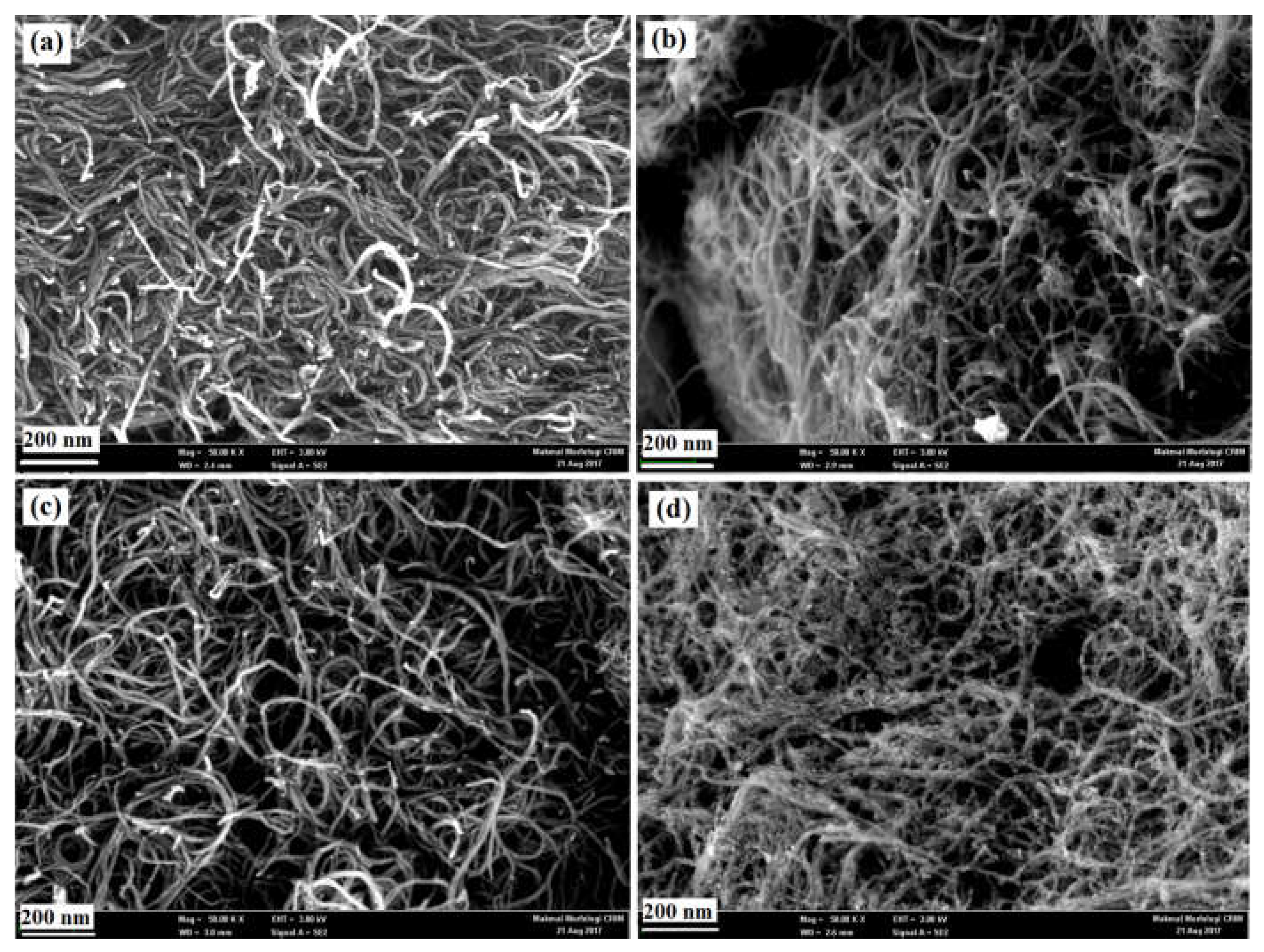
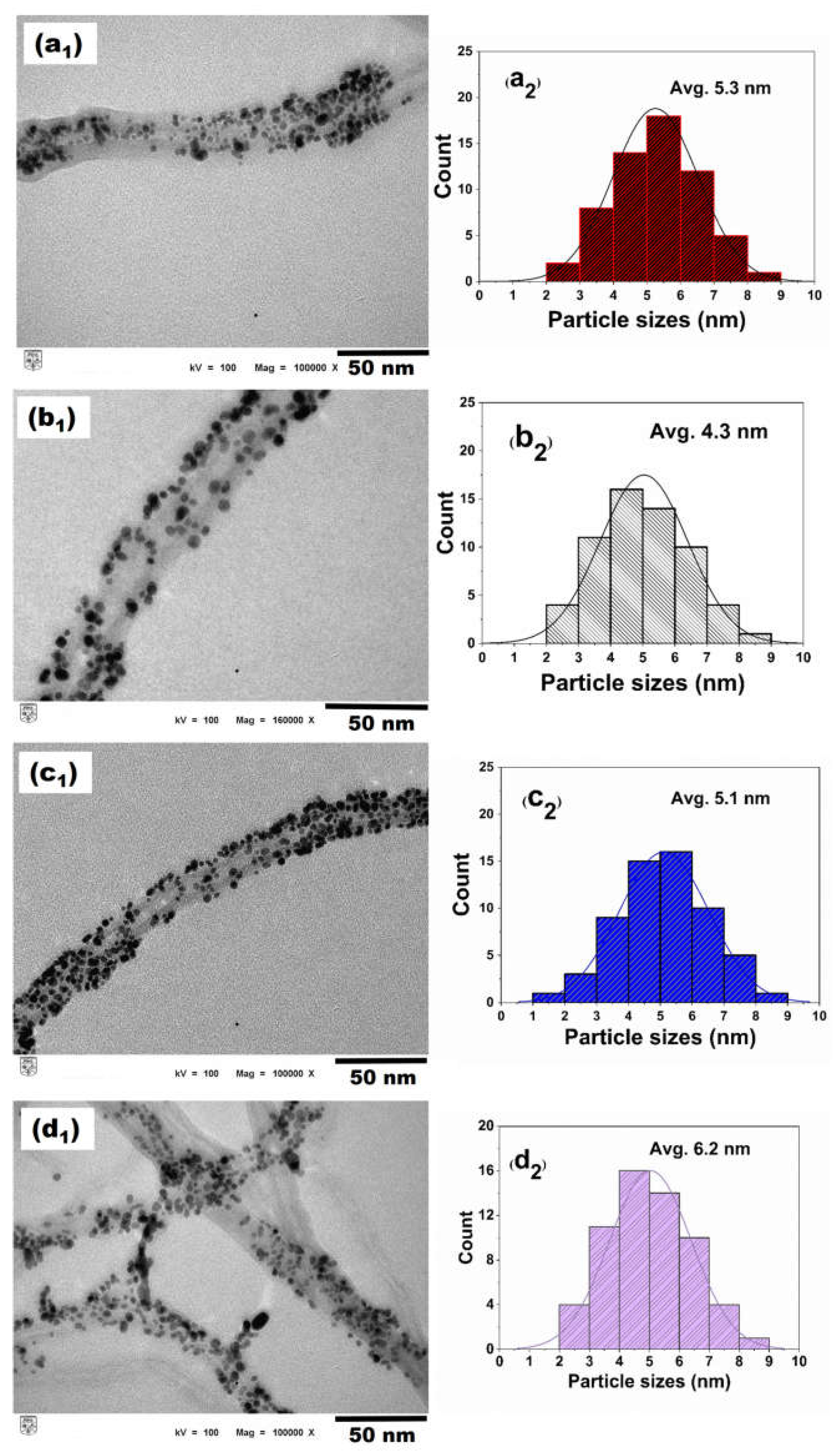
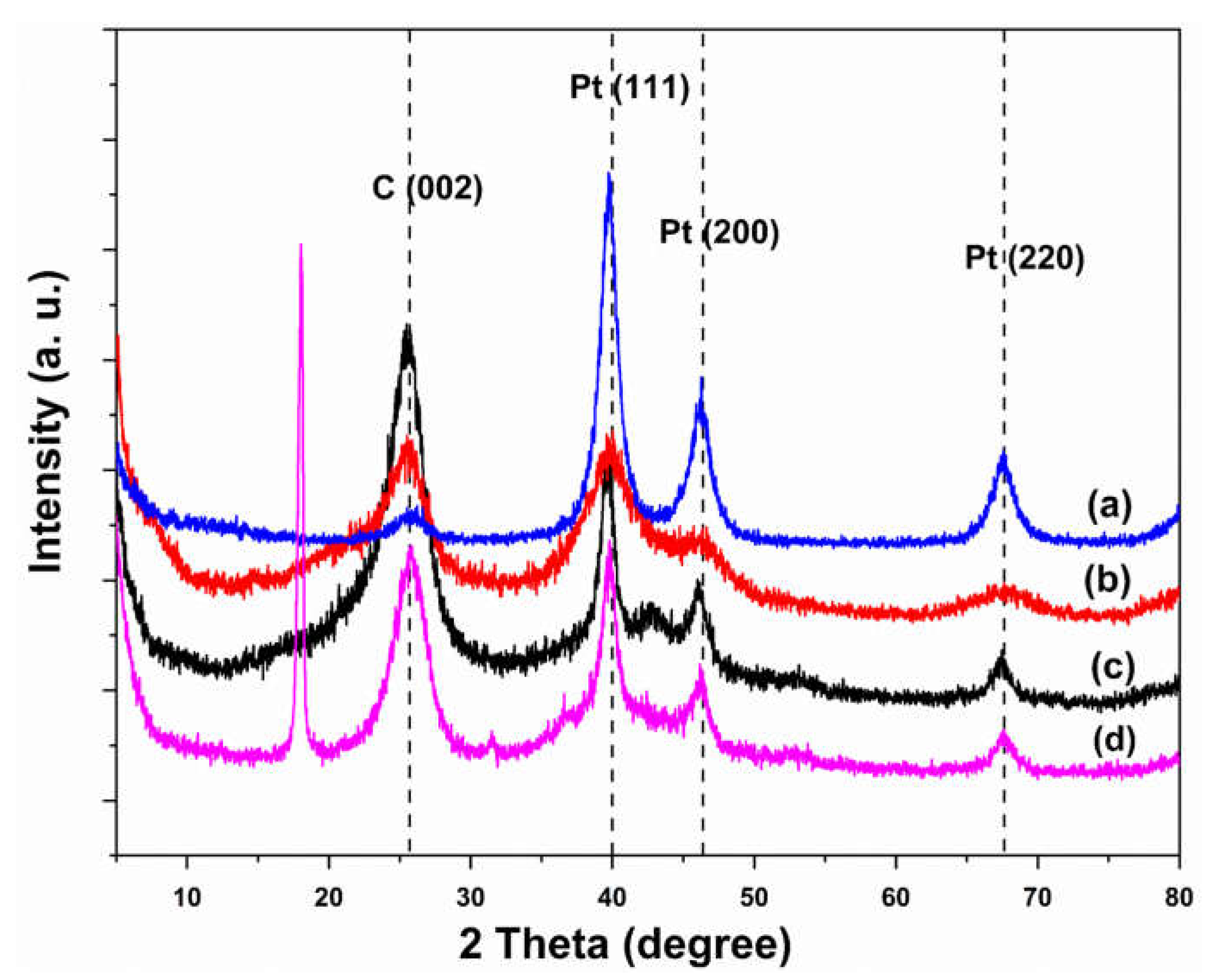
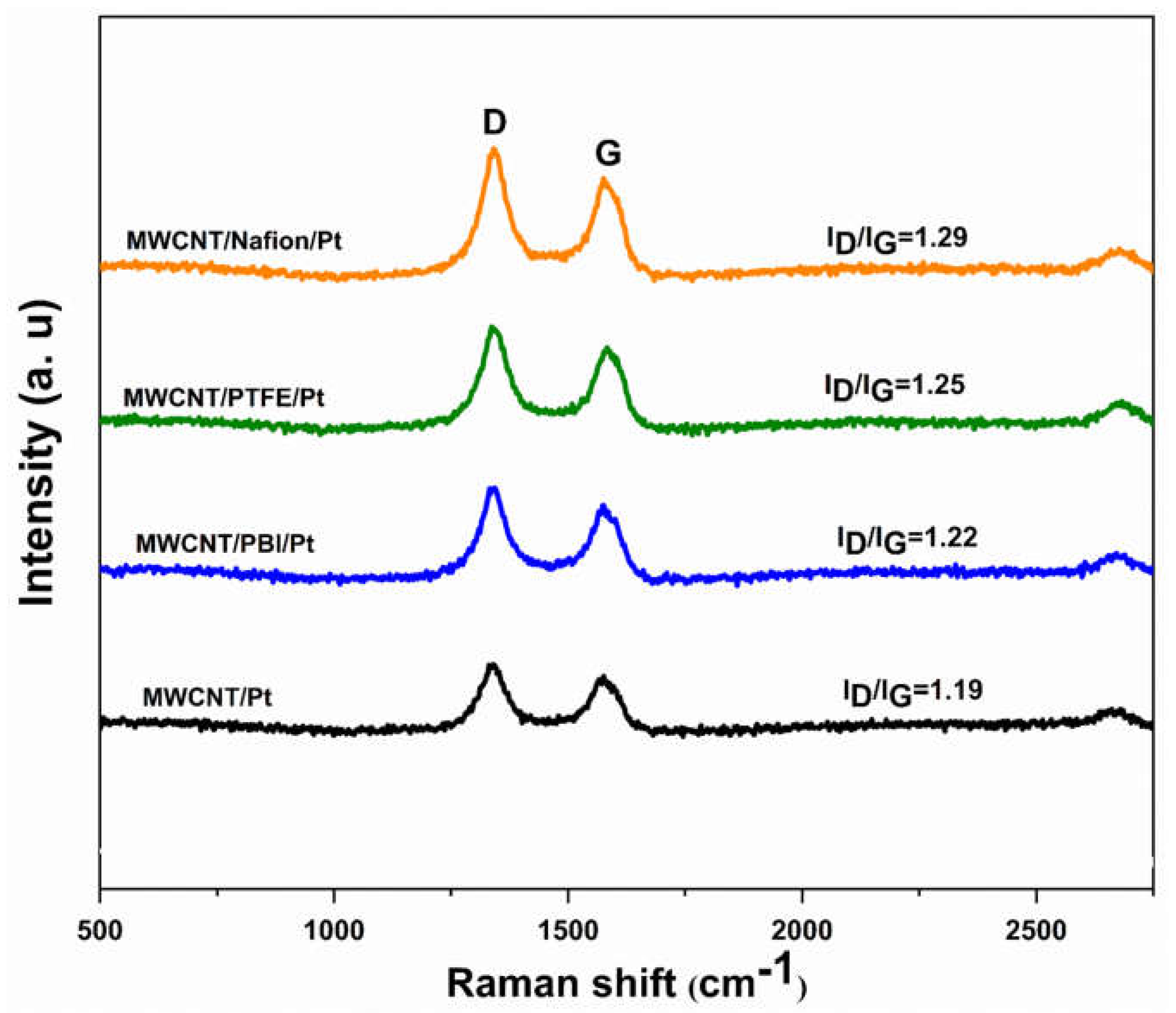
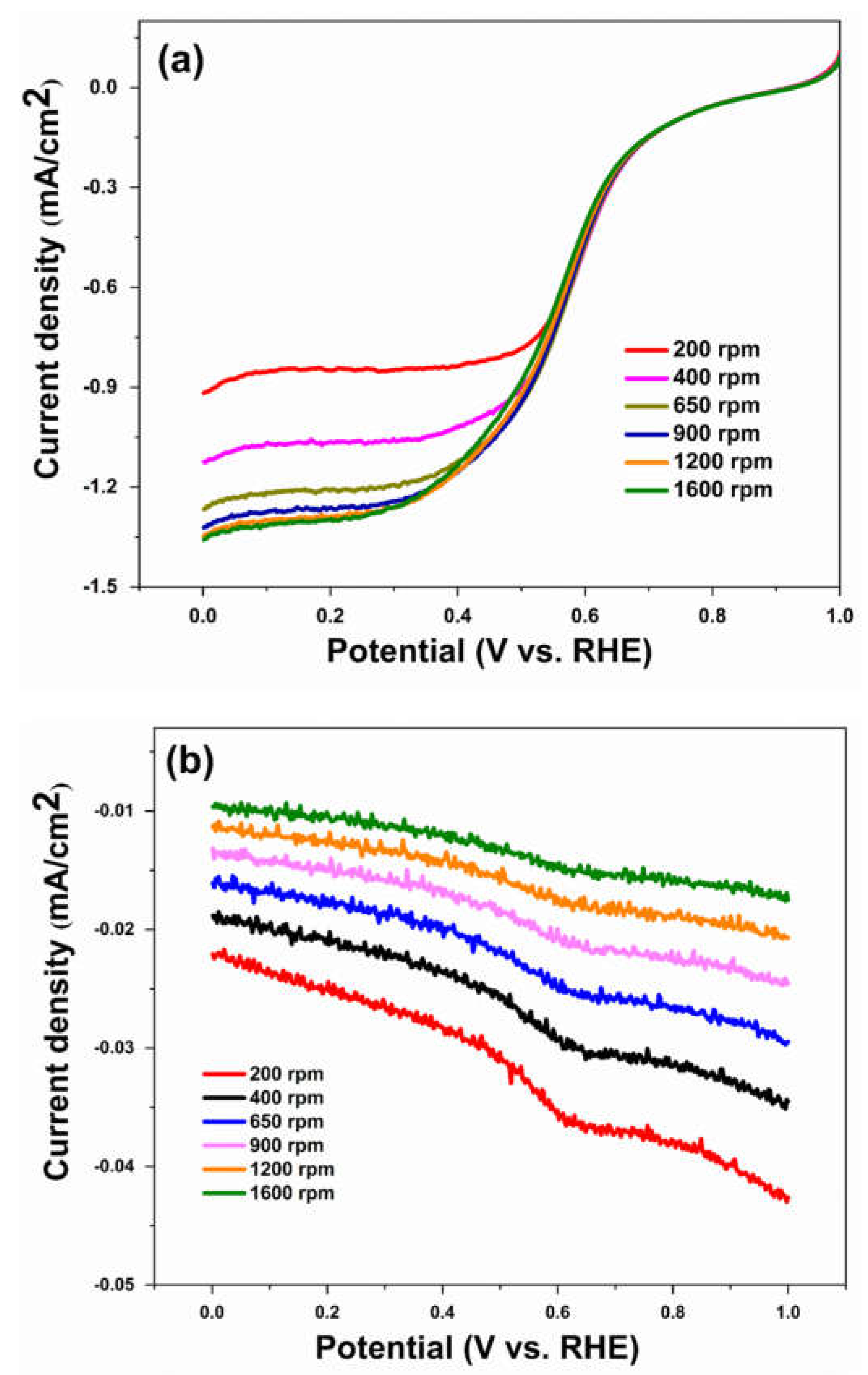
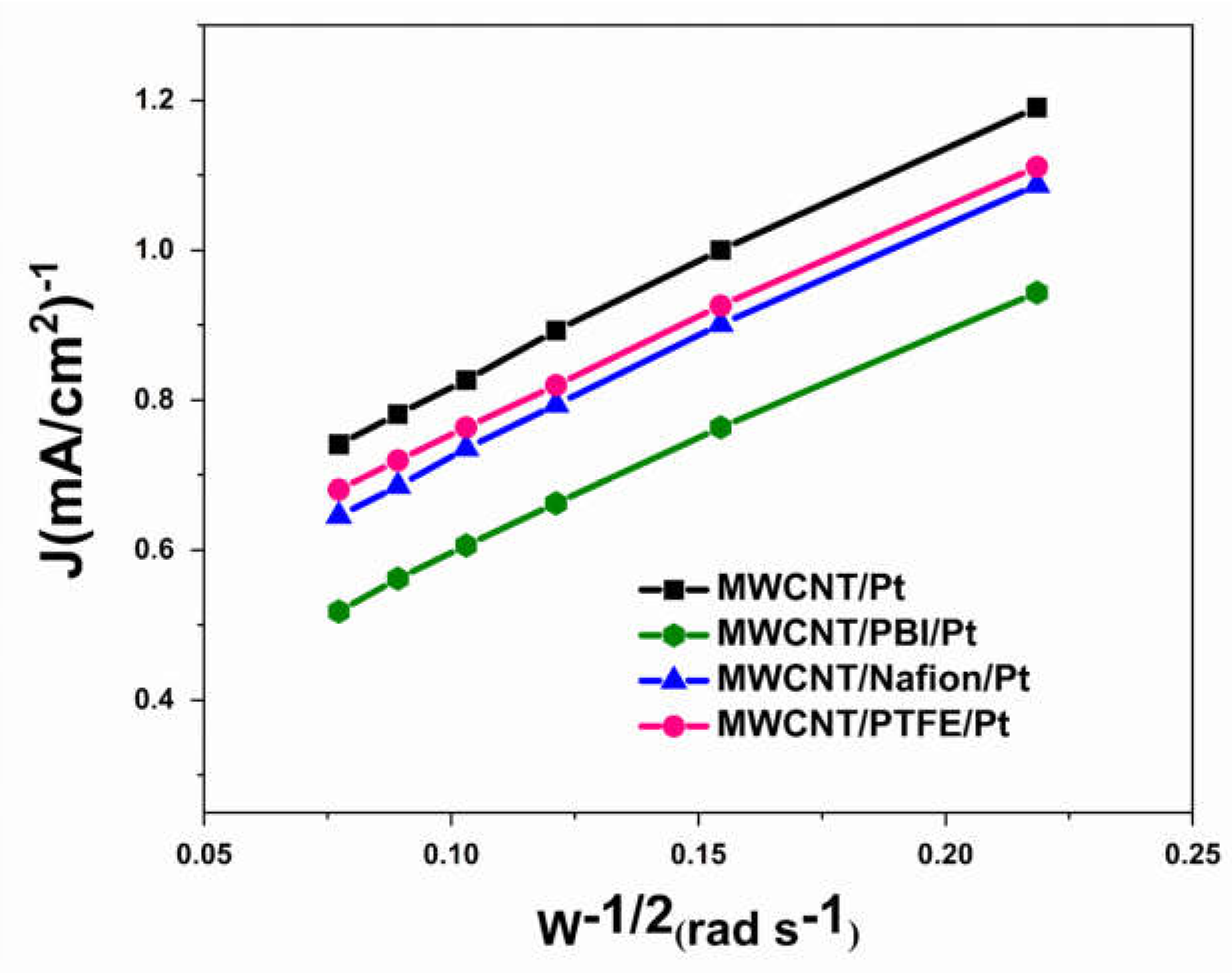
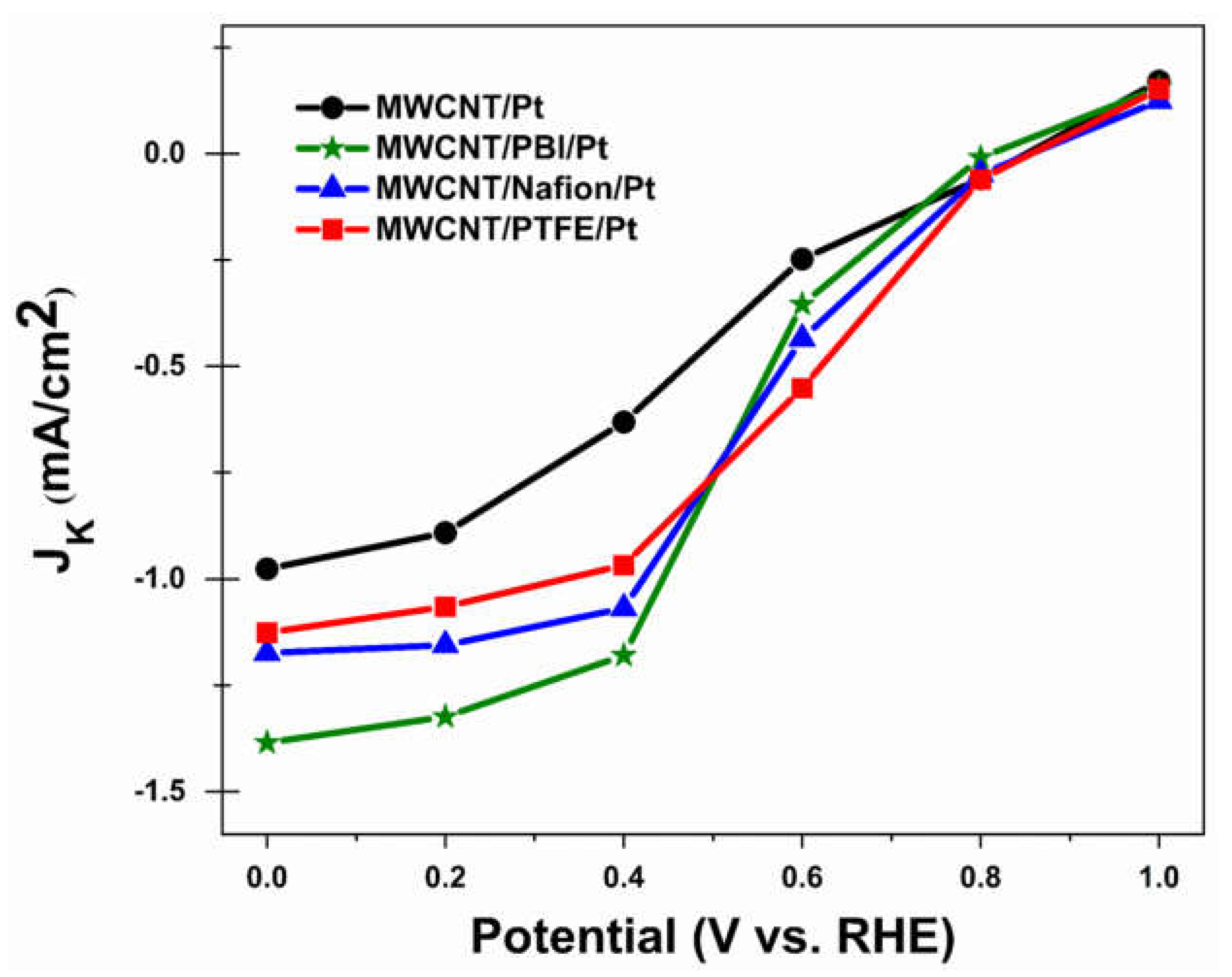

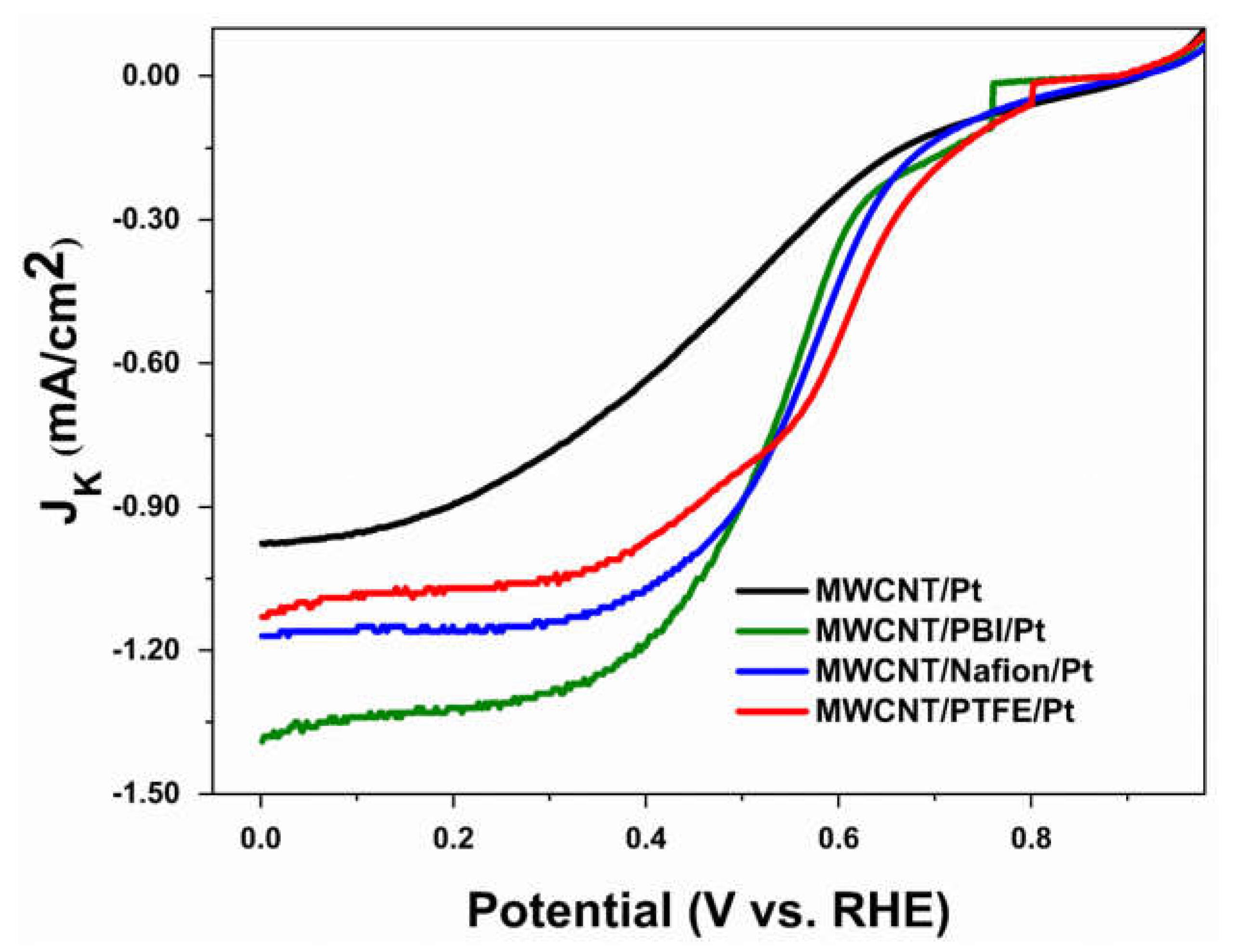
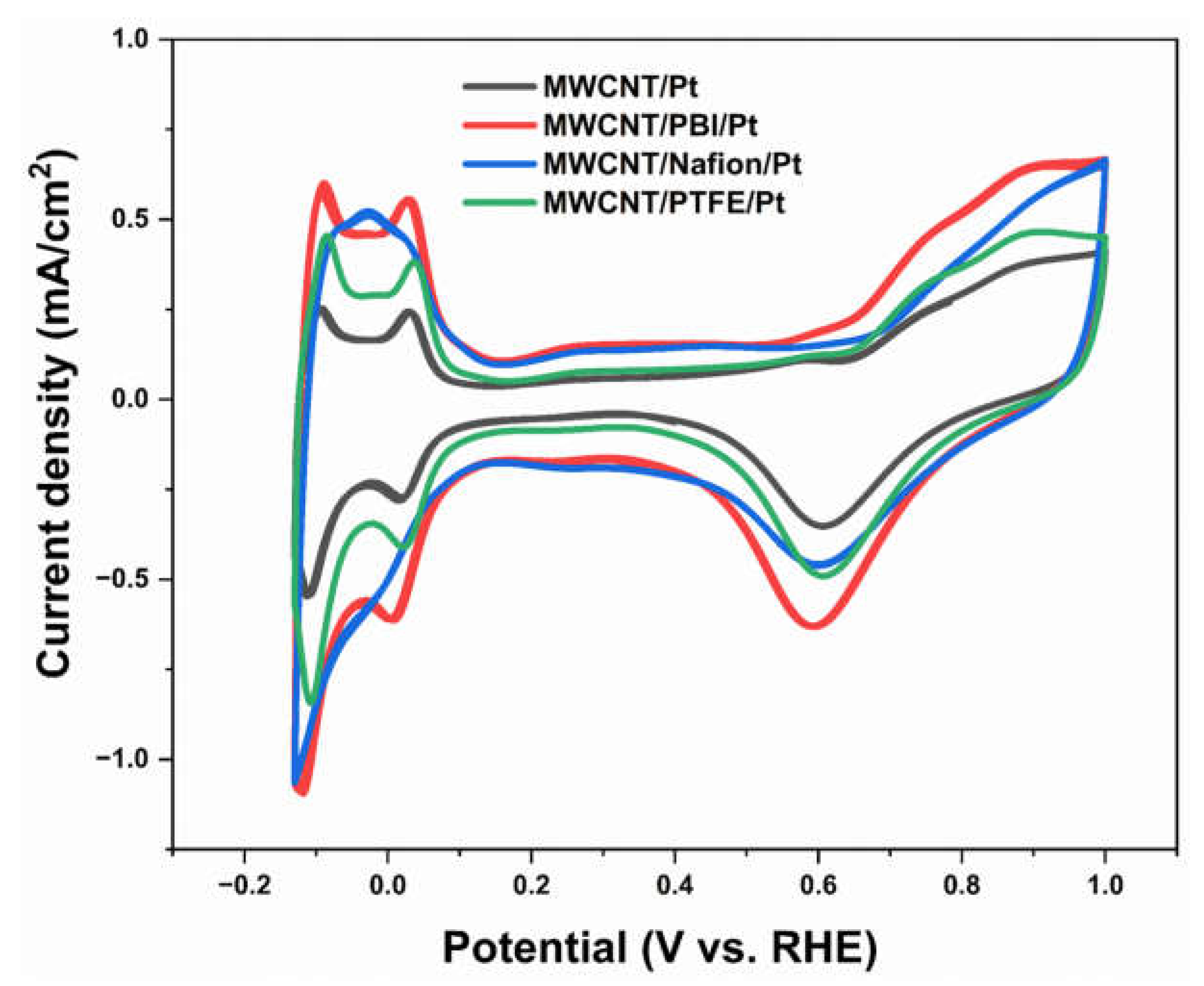
Disclaimer/Publisher’s Note: The statements, opinions and data contained in all publications are solely those of the individual author(s) and contributor(s) and not of MDPI and/or the editor(s). MDPI and/or the editor(s) disclaim responsibility for any injury to people or property resulting from any ideas, methods, instructions or products referred to in the content. |
© 2023 by the authors. Licensee MDPI, Basel, Switzerland. This article is an open access article distributed under the terms and conditions of the Creative Commons Attribution (CC BY) license (https://creativecommons.org/licenses/by/4.0/).
Share and Cite
Haque, M.A.; Rahman, M.M.; Islam, F.; Sulong, A.B.; Shyuan, L.K.; Rosli, R.e.; Chakraborty, A.K.; Haider, J. Kinetics of Oxygen Reduction Reaction of Polymer-Coated MWCNT-Supported Pt-Based Electrocatalysts for High-Temperature PEM Fuel Cell. Energies 2023, 16, 1537. https://doi.org/10.3390/en16031537
Haque MA, Rahman MM, Islam F, Sulong AB, Shyuan LK, Rosli Re, Chakraborty AK, Haider J. Kinetics of Oxygen Reduction Reaction of Polymer-Coated MWCNT-Supported Pt-Based Electrocatalysts for High-Temperature PEM Fuel Cell. Energies. 2023; 16(3):1537. https://doi.org/10.3390/en16031537
Chicago/Turabian StyleHaque, Md Ahsanul, Md Mahbubur Rahman, Faridul Islam, Abu Bakar Sulong, Loh Kee Shyuan, Ros emilia Rosli, Ashok Kumar Chakraborty, and Julfikar Haider. 2023. "Kinetics of Oxygen Reduction Reaction of Polymer-Coated MWCNT-Supported Pt-Based Electrocatalysts for High-Temperature PEM Fuel Cell" Energies 16, no. 3: 1537. https://doi.org/10.3390/en16031537







